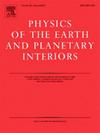SeisTeC: A neural network tool to constrain mantle thermal and chemical properties from seismic observables
IF 1.9
3区 地球科学
Q2 GEOCHEMISTRY & GEOPHYSICS
引用次数: 0
Abstract
Three-dimensional variations of wave speeds and density have identified the presence of seismically distinct structures in the Earth's mantle. To determine the thermochemical properties and dynamic relevance of these structures, it is crucial to understand the relationship between seismic properties and temperature and composition. However, multiple thermochemical parameters influence seismic wave speeds simultaneously. A given wave speed pair (compressional and shear) and density can be generated by many possible combinations of thermochemical parameters, which makes the inversion of wave speeds and density for thermochemical parameters a non-unique problem. We have developed a tool which efficiently captures the mapping between seismic wave speeds (and density) and thermochemical properties, with the capacity to represent both the inherent trade-offs between parameters as well as data uncertainties. These trade-offs and uncertainties are represented by the posterior probability density function provided by a neural network. We demonstrate the concept for seismic wave speeds and density, but the same tool can also be adapted for other parameters such as attenuation or properties of seismic discontinuities. SeisTeC is available to the wider community and is intended to facilitate interpretations of seismic structures inside the Earth, or in general, any planetary bodies.
Our tool is based on a neural network, which implicitly learns the non-linear mapping between temperature and bulk composition. We chose the example of the lower mantle and expressed composition in terms of six end-member oxides () and modelled seismic wave speeds and density at appropriate temperature and pressure conditions. Wave speeds and density are calculated for 750,000 thermochemical models, whose temperature and composition are selected at random from pre-defined ranges, using thermodynamic modelling. We train neural networks with wave speeds plus or minus density as the input, and temperature and bulk composition as target outputs. The networks then approximate a probability density function for each output, which allows us to interpret seismic observables in terms of physical parameters, crucially, with uncertainties. When working with wave speeds ( and ) only, we find trade-offs between pairs of parameters such as temperature - , - , - , and - which limits the constraints one can place on mantle temperature and chemistry using these observables. We also emphasise the importance of combining and for constraining content. The main advantage of including density with wave speeds is that it helps to better constrain the temperature and the most abundant and dynamically relevant compositional end-members, namely, the , and by breaking down the trade-offs between them. Some trade-offs between pairs of parameters involving minor compositional end-members still remain, namely temperature - , - , - . In general, except mid-ocean ridge basalt, most rocks only have a small fraction of and . By excluding mid-ocean ridge basalt in the training data most of the apparent trade-offs will disappear when considering more average mantle compositional ranges.

seisstec:一种神经网络工具,可以从地震观测数据中约束地幔的热力和化学性质
波速和密度的三维变化已经确定了地幔中具有地震特征的结构的存在。为了确定这些结构的热化学性质和动力学相关性,了解地震性质与温度和组成之间的关系至关重要。然而,多个热化学参数同时影响地震波速度。一个给定的波速对(纵波和横波)和密度可以由许多可能的热化学参数组合产生,这使得波速和密度的热化学参数反演成为一个非唯一问题。我们开发了一种工具,可以有效地捕获地震波速度(和密度)与热化学性质之间的映射,能够表示参数之间的固有权衡以及数据不确定性。这些权衡和不确定性由神经网络提供的后验概率密度函数表示。我们演示了地震波速度和密度的概念,但同样的工具也可以适用于其他参数,如衰减或地震不连续面的性质。seisstec可供更广泛的社区使用,旨在促进对地球内部或一般情况下任何行星体的地震结构的解释。我们的工具是基于神经网络,它隐式学习温度和体成分之间的非线性映射。我们以下地幔为例,用6种端元氧化物(SiO2,MgO,Al2O3,FeO,Na2O,CaO)表示其组成,并在适当的温度和压力条件下模拟地震波速度和密度。使用热力学模型,计算75万个热化学模型的波速和密度,这些模型的温度和组成是在预定义的范围内随机选择的。我们用波速加或减密度作为输入,温度和体成分作为目标输出来训练神经网络。然后,网络为每个输出近似一个概率密度函数,这使我们能够根据物理参数解释地震观测值,关键是,具有不确定性。当仅使用波速(VP和VS)时,我们发现了对参数之间的权衡,例如温度- FeO, SiO2 - MgO, SiO2 - Na2O和SiO2 - Al2O3,这限制了人们可以使用这些可观测值对地幔温度和化学的约束。我们还强调了VP和VS相结合对限制SiO2含量的重要性。将密度与波速结合在一起的主要优点是,通过打破它们之间的权衡,它有助于更好地约束温度和最丰富且动态相关的组分端元,即SiO2, MgO和FeO。一些参数对之间的权衡涉及较小的组成端元,即温度- CaO, SiO2 - Na2O, SiO2 - Al2O3。一般来说,除洋中脊玄武岩外,大多数岩石只含有少量的Na2O和Al2O3。通过在训练数据中排除洋中脊玄武岩,当考虑更平均的地幔成分范围时,大多数明显的权衡将消失。
本文章由计算机程序翻译,如有差异,请以英文原文为准。
求助全文
约1分钟内获得全文
求助全文
来源期刊

Physics of the Earth and Planetary Interiors
地学天文-地球化学与地球物理
CiteScore
5.00
自引率
4.30%
发文量
78
审稿时长
18.5 weeks
期刊介绍:
Launched in 1968 to fill the need for an international journal in the field of planetary physics, geodesy and geophysics, Physics of the Earth and Planetary Interiors has now grown to become important reading matter for all geophysicists. It is the only journal to be entirely devoted to the physical and chemical processes of planetary interiors.
Original research papers, review articles, short communications and book reviews are all published on a regular basis; and from time to time special issues of the journal are devoted to the publication of the proceedings of symposia and congresses which the editors feel will be of particular interest to the reader.
 求助内容:
求助内容: 应助结果提醒方式:
应助结果提醒方式:


